7 Best Open Source LLMs
Open Source LLMs (Large Language Models) are not just a fleeting trend but a transformative force in the tech industry. These powerful tools are reshaping how we interact with machines, offering unprecedented capabilities in natural language processing and generation. With the rise of open source LLMs, the landscape is becoming even more exciting, as they provide a platform for innovation, collaboration, and accessibility that was previously unimaginable.
The significance of open source LLMs cannot be overstated. They serve as a beacon of transparency, allowing for a deeper understanding of their inner workings, and they empower users to tailor these models to their specific needs. This democratization of technology is not just beneficial for developers and researchers, it’s a boon for businesses and enthusiasts who are eager to harness the power of AI without the constraints of proprietary systems.
The Need for Open Source LLMs
Open source LLMs are a game-changer by offering a level of customization and flexibility that proprietary models simply cannot match. For enterprises, this means the ability to fine-tune models to their unique requirements, ensuring that the AI aligns perfectly with their operational needs. The open source approach also sidesteps the potential pitfalls of vendor lock-in, granting users the freedom to innovate without being tethered to a single provider’s ecosystem.
Moreover, open source LLMs are a testament to the collaborative spirit of the tech community. They thrive on the contributions of countless individuals who share a common goal: to advance the field of AI. This collective effort not only accelerates the pace of innovation but also ensures that the models are robust, secure, and less prone to biases, thanks to the diverse perspectives involved in their development.
In conclusion, the rise of open source LLMs is a clear indicator of the industry’s commitment to openness, collaboration, and inclusivity. As these models continue to evolve and improve, they promise to unlock new possibilities and drive progress across various sectors. Whether you’re a seasoned AI practitioner or just starting to explore the potential of these models, the future of open source LLMs is bright and brimming with opportunity.
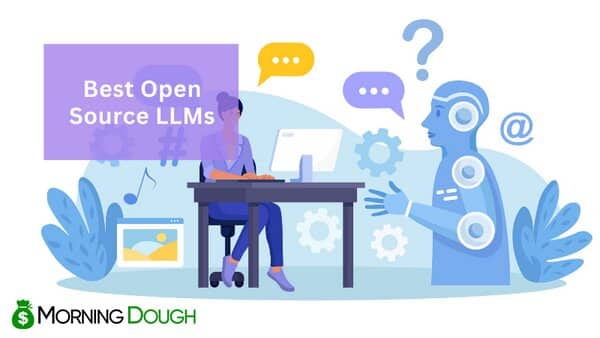
7 Best Open Source LLMs
How do Open Source LLMs work?
Open Source LLMs are at the forefront of the AI revolution, offering a versatile and powerful tool for a wide range of applications. These models are trained on vast datasets comprising text from the internet, books, articles, and more, enabling them to understand and generate human-like text. The open source nature of these LLMs means that their code and sometimes other components are freely available for anyone to use, modify, and distribute. This accessibility fosters innovation and collaboration within the tech community, allowing developers to fine-tune models for specific tasks or integrate them into larger systems. Open Source LLMs work by processing input text through layers of neural networks, predicting the next word in a sequence based on the context provided by the previous words. This capability allows them to perform tasks such as text generation, translation, summarization, and more with remarkable accuracy.
How to choose Open Source LLMs?
Choosing the right Open Source LLMs for your project involves considering several key factors to ensure the model meets your specific needs. First, assess the model’s accuracy for tasks relevant to your application, as higher accuracy models will deliver better performance. Consider the technical requirements and ensure they align with your infrastructure capabilities, including hardware and computational resources. It’s also crucial to review the licensing terms of the model to understand usage rights, modifications, and distribution requirements. Scalability is another important factor, the model should be able to handle increasing demands and data sizes efficiently. Integration capabilities are essential as well, the model should be compatible with the programming languages, frameworks, and APIs you plan to use. Finally, consider whether the model supports transfer learning, which allows you to fine-tune a pre-trained model on your specific task, saving time and resources compared to training a model from scratch. By carefully evaluating these factors, you can select Open Source LLMs that best fit your project’s needs and maximize the potential of AI in your application.
Open Source LLMs
1. Mistral
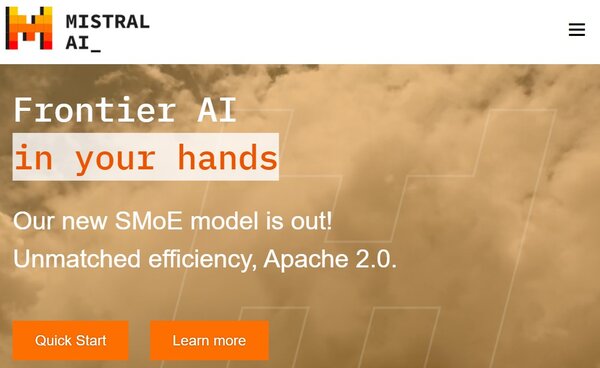
Mistral is an open source LLM and AI platform that addresses some of the most challenging aspects of AI models, focusing on computational efficiency, usefulness, and trustworthiness. This open source LLM platform is at the forefront of open model initiatives, providing users with transparent access to model weights, which allows for extensive customization. Mistral is committed to the principles of open science, community engagement, and free software, releasing many of its models and deployment tools under permissive licenses to foster a reciprocal relationship with the open source software (OSS) community.
What does Mistral do?
Mistral provides an early generative AI platform that is currently in early access. This open source LLM platform serves optimized models for generation and embeddings that are open for use. Mistral stands out for its speed and power, being six times faster while matching or outperforming its counterparts like Llama 2 70B on all benchmarks. The platform supports multiple languages, exhibits natural coding abilities, and can handle sequences up to 32,000 in length. Users have the flexibility to access Mistral through an API or deploy it independently, thanks to its Apache 2.0 licensing.
Mistral Key Features
Compute Efficiency: Mistral is designed to be highly efficient in terms of computation, providing a fast and powerful model that does not compromise performance.
Helpful and Trustworthy: The platform aims to create AI models that are not only helpful in their application but also trustworthy, ensuring users can rely on the outputs generated.
Open Model Family: As a leader in open models, Mistral encourages transparency and customization, allowing users to adapt the models to their specific needs.
Community and Free Software: With a strong belief in open science and community, Mistral releases its models and tools under permissive licenses, promoting a culture of sharing and collaboration.
Early Access Generative AI Platform: Users can access Mistral’s generative AI platform in its early stages, taking advantage of its optimized models for generation and embeddings.
Multilingual Support and Coding Abilities: The platform is capable of understanding and generating text in multiple languages and has innate coding capabilities, making it versatile across various use cases.
Long Sequence Handling: Mistral can process long sequences of up to 32,000, which is beneficial for complex tasks that require extensive context.
Flexible Deployment: The model is available through an API or for independent deployment, with an Apache 2.0 license that facilitates ease of use and integration.
2. Llama 2
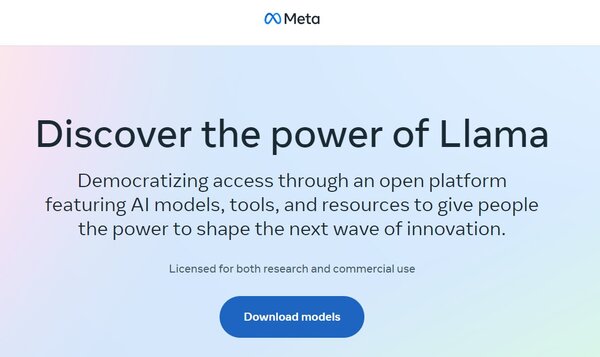
Llama 2 is an open source LLM (Large Language Model) developed by Meta, designed to democratize access to advanced AI capabilities. It is licensed for both research and commercial use, offering a unique opportunity for developers to engage with state-of-the-art AI technology. Llama 2 is part of a broader initiative to foster open collaboration and innovation within the AI community. By providing access to this powerful tool, Meta aims to empower people to shape the next wave of innovation in various fields.
What does Llama 2 do?
Llama 2 functions by predicting plausible follow-on text based on input it receives, utilizing a neural network with a transformer architecture. This allows it to generate responses that are remarkably human-like in their construction and relevance. The model is capable of understanding and generating natural language as well as code, making it a versatile tool for a wide range of applications. From aiding developers in coding tasks to facilitating research in natural language processing, Llama 2 serves as a multifaceted platform that can be fine-tuned and customized for specific use cases.
Llama 2 Key Features
Pretrained and Fine-Tuned Models: Llama 2 includes a collection of models that have been pretrained on vast datasets and fine-tuned for specific tasks, such as dialogue. This fine-tuning process has been meticulously carried out with an emphasis on safety and helpfulness, ensuring that the models are not only effective but also responsible in their interactions.
Open Source Accessibility: One of the most significant aspects of Llama 2 is its open source nature. Unlike many proprietary models, Llama 2’s code and training details are available for scrutiny, allowing developers and researchers to understand its inner workings and contribute to its development.
Customization and Flexibility: With Llama 2, users have the freedom to train the model on their own data, fine-tune it for particular tasks, and even delve into its underlying code. This level of customization and flexibility is invaluable for creating AI applications that are tailored to specific needs and objectives.
Community and Collaboration: By making Llama 2 open source, Meta has created a platform for global collaboration. Developers and researchers from around the world can contribute to the model’s improvement, share insights, and collectively push the boundaries of what AI can achieve.
Alignment with Safety and Innovation: Meta has taken steps to ensure that Llama 2 aligns with principles of safety and innovation. The model has undergone red-teaming exercises and external adversarial testing to identify and address potential vulnerabilities, reflecting a commitment to responsible AI development.
3. Vicuna-13B
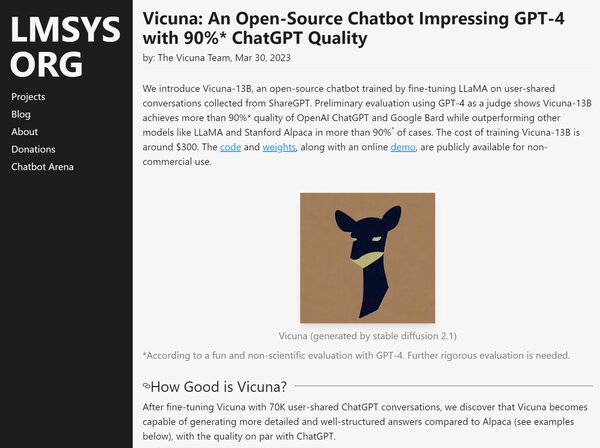
Vicuna-13B is an innovative open source chatbot model that has been fine-tuned on a LLaMA base model using around 70,000 user-shared conversations. This process ensures a high-quality dataset by converting HTML to markdown and filtering out inappropriate or low-quality samples. Vicuna-13B is distinguished by its ability to generate systematic and high-quality answers, demonstrating impressive performance that rivals even GPT-4 in certain aspects. The model’s development emphasizes improvements in memory optimization and the handling of multi-round conversations, making it a significant contribution to the field of natural language processing and AI chatbots.
What does Vicuna-13B do?
Vicuna-13B excels in generating coherent and contextually relevant text responses, making it an excellent tool for various applications, including customer service, educational tools, and more. By leveraging a vast dataset of user-shared conversations and employing advanced fine-tuning techniques, Vicuna-13B can understand and participate in complex dialogues, offering responses that closely mimic human conversational patterns. This capability is further enhanced by its ability to handle extended conversation lengths, allowing for more in-depth interactions. The model’s open source nature also encourages ongoing improvements and adaptations by the global tech community.
Vicuna-13B Key Features
Fine-Tuned LLaMA Base Model: Vicuna-13B leverages a robust foundation, enabling it to deliver high-quality, context-aware responses across a wide range of topics and scenarios.
Improved Accuracy: The model stands out for its exceptional ability to generate responses that are not only relevant but also precise, thanks to its comprehensive training on a diverse dataset.
Open Source Availability: Vicuna-13B is freely accessible for use, modification, and distribution, fostering innovation and collaboration within the AI and tech communities.
Versatile Application: From enhancing customer service experiences to serving as a dynamic tool for language learning and research, Vicuna-13B’s capabilities make it a valuable asset across various fields.
Cost Effective Training: The model’s development process has been optimized to reduce training costs significantly, making advanced AI chatbot technology more accessible.
Safety and Bias Mitigation: Efforts have been made to address safety concerns and reduce potential biases in the model’s outputs, although ongoing work is needed in this area.
4. Bloom
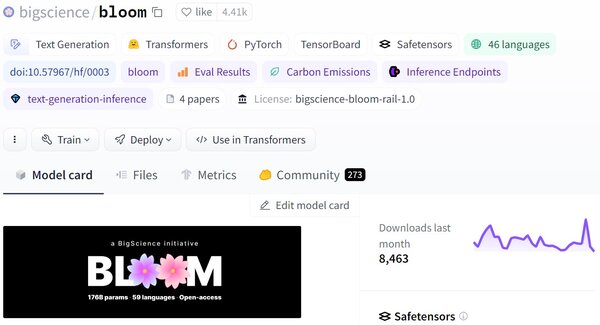
Bloom is an open source MML developed by the BigScience research workshop. With 176 billion parameters, Bloom can generate text in 46 natural languages and 13 programming languages, making it one of the most extensive multilingual models available to the public. It was trained transparently on the Jean Zay supercomputer and is designed to be a collaborative effort, involving over 1000 researchers from more than 70 countries. Bloom is part of an initiative to provide academia, nonprofits, and smaller research labs with access to high-quality open source LLMs, which have traditionally been the domain of well-resourced industrial labs.
What does Bloom do?
Bloom performs a variety of language tasks by generating coherent text from prompts. It is an autoregressive model that can produce text hardly distinguishable from that written by humans. Beyond text generation, Bloom can execute tasks it hasn’t been explicitly trained for by framing them as text generation challenges. This includes the ability to understand and generate content in multiple languages and programming codes, making it a versatile tool for researchers and developers looking to explore the capabilities of open source LLMs.
Bloom Key Features
Multilingual Capabilities: Bloom stands out for its ability to understand and generate text in a wide array of languages, including those that are underrepresented in the AI field. This feature is particularly beneficial for global applications and research.
Extensive Collaboration: The development of Bloom is the result of an unprecedented collaborative effort, bringing together a diverse group of researchers and volunteers. This collective approach to AI development encourages a more inclusive and comprehensive model.
Transparent Training Process: Unlike proprietary models, Bloom’s training process is completely transparent, providing insights into its development and allowing for a broader understanding of its functions and potential improvements.
Responsible AI License: Bloom is governed by the Responsible AI License, which aims to ensure ethical use and prevent misuse of the technology. This reflects a commitment to responsible AI development and deployment.
Continuous Improvement: The BigScience workshop intends to continuously update and improve Bloom, adding new languages and features, and refining its capabilities. This ongoing development ensures that Bloom remains a cutting-edge tool in the field of AI.
5. GPT-NeoX-20B
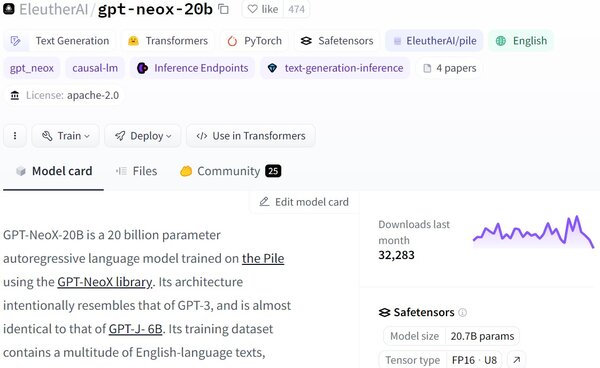
GPT-NeoX-20B is a product of EleutherAI, a collective focused on democratizing and advancing AI research. This model is a part of the GPT-NeoX series, designed to provide an open source LLM alternative to proprietary models like GPT-3. With 20 billion parameters, GPT-NeoX-20B is engineered to understand and generate English-language text, making it a powerful tool for a variety of natural language processing tasks. Its development and release under an open source license aim to foster innovation and research in the AI community, providing a robust platform for experimentation and application development.
What does GPT-NeoX-20B do?
GPT-NeoX-20B specializes in generating human-like text by predicting the next token in a sequence based on the context provided by the input text. This capability enables it to perform a wide range of tasks, including content creation, summarization, and question-answering, among others. However, it’s important to note that while GPT-NeoX-20B excels at generating coherent and contextually relevant text, it is designed exclusively for English language processing and does not support translation or text generation in other languages. Users should also be cautious of its limitations and biases, as the model’s outputs may not always be factually accurate or free from unintended biases.
GPT-NeoX-20B Key Features
English-Language Specialization: GPT-NeoX-20B is tailored for processing and generating English-language text, making it a specialized tool for tasks that require a deep understanding of English syntax and semantics.
20 Billion Parameters: The model’s vast number of parameters enables it to capture a wide range of linguistic nuances, allowing for the generation of highly sophisticated and varied text outputs.
Open Source Availability: By being available under an open source license, GPT-NeoX-20B encourages collaboration and innovation within the AI research community, allowing developers and researchers to modify and build upon the model.
Content Creation and Summarization: Its ability to predict the next token in a sequence makes it highly effective for creating engaging content and summarizing existing text, offering valuable applications in fields such as journalism, marketing, and education.
Limitations and Biases Awareness: The developers of GPT-NeoX-20B openly acknowledge the model’s limitations and potential biases, promoting a responsible approach to its deployment and use in applications.
GPT-NeoX-20B represents a significant contribution to the landscape of open source MML, offering a powerful tool for English text generation and analysis while also highlighting the importance of ethical considerations in AI development.
6. MPT-7B
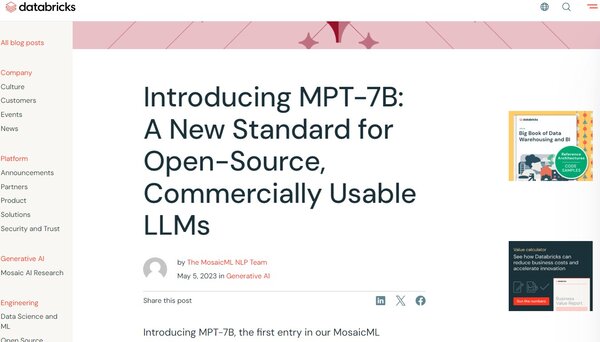
MPT-7B emerges from MosaicML’s extensive two-year endeavor to create a new benchmark in open source, commercially viable open source LLMs. This model is part of a broader initiative that includes open source software such as Composer, StreamingDataset, and LLM Foundry, alongside proprietary infrastructure like MosaicML Training and Inference. MPT-7B is designed to democratize the training of LLMs, offering unparalleled efficiency, privacy, and cost transparency. It enables customers to train open source LLMs across any compute provider and data source, ensuring optimal outcomes from the outset. MPT-7B is positioned as an ideal starting point for those looking to build custom LLMs for private, commercial, or community purposes, whether the goal is to fine-tune existing checkpoints or train entirely new models from scratch.
What does MPT-7B do?
MPT-7B facilitates the creation and deployment of custom Large Language Models with an emphasis on accessibility, efficiency, and commercial viability. It supports the training of open source LLMs on diverse compute platforms and data sources, addressing the critical needs of privacy and cost-effectiveness. This model stands out by providing a solid foundation for both fine-tuning pre-existing models and developing new ones from the ground up. MPT-7B’s integration with MosaicML’s suite of tools and infrastructure simplifies the otherwise complex process of LLM development, making it more approachable for a wide range of users, from individual developers to large enterprises.
MPT-7B Key Features
Open Source Software Integration: MPT-7B is closely integrated with open source tools like Composer, StreamingDataset, and LLM Foundry, enhancing its flexibility and ease of use.
Proprietary Infrastructure Compatibility: It works seamlessly with MosaicML’s proprietary training and inference infrastructure, offering a balanced approach between open source flexibility and proprietary efficiency.
Custom LLM Building: The platform is designed to be the go-to solution for building custom open source LLMs tailored to specific private, commercial, or community needs.
Efficiency and Privacy: MPT-7B prioritizes efficiency in training processes and safeguards privacy, addressing two of the most significant concerns in LLM development.
Cost Transparency: It introduces a level of cost transparency previously unseen in LLM training, allowing users to manage budgets more effectively.
Versatility Across Compute Providers: The model’s design ensures it can be trained across any compute provider, offering unparalleled versatility and freedom.
MPT-7B represents a significant step forward in the democratization of Large Language Model development, combining the best of open source software and proprietary infrastructure to meet the diverse needs of the AI community.
7. Falcon

Falcon is a generative large language model developed to enhance applications and use cases across various domains. With a suite of models ranging from 1.3B to 180B parameters, Falcon is designed to be versatile and adaptable to both research and commercial needs. The model is accompanied by the REFINEDWEB dataset, ensuring a high-quality training foundation. Falcon’s open source LLM nature underlines a commitment to transparency and collaboration in AI development, allowing for widespread use and innovation.
What does Falcon do?
Falcon excels in generating coherent and contextually relevant text, making it a powerful tool for natural language processing tasks. Its ability to understand and produce human-like text across different contexts allows it to be used for a variety of applications, from chatbots and virtual assistants to more complex language modeling projects. Falcon’s design facilitates dynamic and interactive conversational experiences, enabling users to engage with the model in a way that mimics human interaction.
Falcon Key Features
Diverse Model Sizes: Falcon offers a range of models with different parameter counts, catering to various computational needs and use cases. This diversity allows users to select the most appropriate model size for their specific application, balancing performance, and resource requirements.
REFINEDWEB Dataset: The quality of Falcon’s training is bolstered by the REFINEDWEB dataset, which provides a rich and diverse foundation for the model’s language capabilities. This dataset contributes to the model’s ability to generate high-quality, nuanced text.
Open Source and Open Access: Falcon’s open source availability ensures that it can be freely used and modified, fostering innovation and allowing a broad community of developers and researchers to contribute to its evolution.
Versatility in Applications: The model’s design and training enable it to perform well across a wide range of natural language processing tasks, making it a flexible tool for both research and commercial projects.
Optimization for Performance: Falcon has been optimized for efficiency, reducing the computational resources needed for training and deployment, which makes it more accessible, especially in scenarios with limited computational power.
FAQs on Open Source LLMs
What is an Open Source LLMs?
Open Source MMLs (Open Source Large Language Models) are a type of artificial intelligence technology designed to understand, interpret, and generate human-like text. These models are trained on extensive datasets, including a wide variety of text sources such as websites, books, and articles. The “open source” aspect means that the model’s source code, and sometimes additional components like training data and pre-trained models, are available for anyone to access, modify, and distribute. This openness encourages a collaborative approach to development and innovation, allowing researchers, developers, and businesses to adapt the models to their specific needs and challenges.
How do Open Source LLMs benefit the tech community?
The primary benefit of Open Source LLMs to the tech community is their role in democratizing AI technology. By providing access to state-of-the-art models, they lower the barriers to entry for individuals and organizations looking to explore and innovate in the field of AI. This accessibility fosters a collaborative environment where improvements and innovations can be shared, leading to more robust, efficient, and fair models. Additionally, open source models allow for greater transparency in AI, enabling users to understand and trust the technology they are using by examining the underlying code and training processes.
Can Open Source LLMs be customized for specific applications?
Yes, one of the significant advantages of Open Source LLMs is their flexibility and adaptability for specific applications. Developers can fine-tune these models on specialized datasets to enhance their performance on tasks, such as legal document analysis, medical research summarization, or customer service automation. This customization process involves adjusting the model’s parameters and training it further on data that reflects the specific context or domain of interest, resulting in improved accuracy and relevance for the intended application.
What challenges are associated with using Open Source LLMs?
While Open Source LLMs offer numerous benefits, they also present several challenges. One major challenge is the requirement for substantial computational resources for training and fine-tuning these models, which can be prohibitive for individuals or small organizations. Additionally, managing and processing the large datasets needed for training can be complex and resource intensive. Another challenge is ensuring the ethical use of these models, as they can sometimes generate biased or inappropriate content if not carefully monitored and adjusted. Finally, navigating the licensing and usage rights of open source models can be complicated, requiring careful attention to ensure compliance.
How can one contribute to the development of Open Source LLMs?
Contributing to the development of Open Source LLMs can take many forms. Developers, researchers, and enthusiasts can contribute by sharing improvements to the model’s architecture, optimizing its performance, or enhancing its security. Contributions can also include providing or curating high-quality training datasets, which are crucial for the model’s ability to understand and generate relevant and unbiased content. Additionally, documenting use cases, writing tutorials, and providing feedback on the model’s performance in various applications are valuable contributions that help the community leverage these models more effectively.
Conclusion
The exploration of Open Source MMLs reveals a dynamic and promising field within artificial intelligence that stands to significantly impact how we interact with technology. These models, characterized by their ability to understand and generate human-like text, are not only advancing the frontiers of natural language processing but are also fostering a culture of collaboration and innovation. The nature of these open source LLMs democratizes access to cutting-edge AI, enabling a broad spectrum of users to customize, improve, and apply these models in diverse and meaningful ways. Despite the challenges associated with their use, the potential benefits and opportunities they present make Open Source LLMs a pivotal development in the ongoing evolution of AI technology. As the community continues to grow and contribute, we can expect these models to become even more sophisticated, accessible, and impactful.